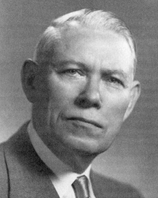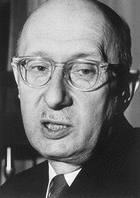ˇ@
Ernest Wever & Charles Bray
ˇ@
In 1930, The Journal of Experimental Psychology received Ernest G. Wever and Charles W. Brayˇ¦s manuscript, ˇ§The Nature of the Acoustic Response: The Relation Between Sound Frequency and Frequency of Impulses in the Auditory Nerve.ˇ¨ Wever and Bray later received the first Society of Experimental Psychologistsˇ¦ Howard C. Warren Medal for this work in 1936.
Ernest Glen Wever (1902-1991)

Ernest Glen Wever was born October 16, 1902 in Benton, IL. He received an A.B. degree from Illinois College in 1922, and the MA and PhD degrees from Harvard University in 1924 and 1926. he was married in 1928. After a year as an instructor at U.C. Berkeley (1926-1927), Wever moved to the Department of Psychology at Princeton University where he remained. During 1936, he worked on a fellowship at the Otological Research Laboratory at Johns Hopkins University with Stacy Guild and S. J. Crowe. He was named the Dorman T. Warren Professor (1946-1950), and the Eugene Higgins Professor (1950-1971) at Princeton. He was a consultant to the National Defense Research Committee on anti-submarine warfare during World War II. He was a Research Associate at the Lempert Institute of Otology in New York (1947-1957) and served as Psychology Department Chair at Princeton from 1955 to 1958.
Wever had three careers in hearing research: First, with Charles Bray, Merle Lawrence, and Jack Vernon he discovered and further investigated the cochlear potential (referred to the as the "cochlear microphonic" by some), and used it as a tool for investigating the biomechanical function of the outer, middle, and inner ears. This work culminated in Physiological Acoustics (E.G. Wever and Merle Lawrence, Princeton University Press, 1954). This book was a "bible" in its time, and few volumes of its scope has been attempted since. Second, Wever reviewed, evaluated, and developed contemporary theories of hearing, including his well-known volley principle which he combined with a place principle to account for frequency analysis (the volley theory). This work was published as Theory of Hearing in 1949. This book remains today the most ambitious, complete, and well-written book on hearing. He once remarked to me that his initial work leading to a formulation of the volley principle was done to obtain evidence against temporal representations of frequency in the mammalian ear. Third, Wever founded, and for several decades maintained the modern field of the evolutionary biology of hearing. It is clear from his bibliography that he was interested in evolutionary issues from the start (early '30s), and began studies on both vertebrates and invertebrates. These interests in comparative and evolutionary issues in hearing brought forth The Reptile Ear in 1978 and The Amphibian Ear in 1985, both from Princeton University Press. These books are unparalleled treatises on the comparative study of the ear. Beginning in the 1960s, Wever's comparative interests came to dominate his work and thinking for three decades. It is characteristic of Glen Wever that when reporters from Newsweek Magazine asked him in 1970 why a psychologist would be studying the structures and physiology of reptile ears, he answered, "It's where the questions took me."
Wever was elected to the National Academy of Sciences and the National Academy of Arts and Sciences, and was a fellow of the Acoustical Society of America and the Society of Experimental Psychologists. He had received the following additional honors: Howard Crosby Warren Medal from the Society of Experimental Psychologists (1931), the George Shambaugh Prize in Otology (1957), The Gold Medal and Certificate of Merit from the American Otological Society (1959), Honors of the Association from the American Speech and Hearing Association (1967), The Beltone Institute for Hearing Research Award (1969), and was the Guest of Honor at the 104th meeting of the American Otological Society (1971). In 1981 he received the Silver Medal in Psychological and Physiological Acoustics from the Acoustical Society of America, and in 1983 received the Award of Merit from the Association for Research in Otolaryngology.
Wever and Georg von Bekesy became good friends during the '50s following a period during which Wever was rather critical of von Bekesy's work. Von Bekesy cherished the new friendship but regretted loosing his most valuable critic when relations turned personally warm. Wever translated from the German and edited all von Bekesy's papers published up to 1948 to produce the book, Experiments in Hearing. This scholarship on Glen's part probably played a role in von Bekesy's winning the 1961 Nobel Prize in Physiology and Medicine. Some additional information about E.G. Wever, including photographs, can be found in Hearing and Other Senses: Presentations in Honor of E.G. Wever, R. Fay and G. Gourevitch (Eds.), Amphora Press, Groton, CT, 1983, a volume reporting the presentations at a meeting of former students and present colleagues on the occasion of Wever's retirement. In 1982, a video tape was made of Frank Geldard interviewing Glen about his earliest years in research. The symposium "Evolutionary Biology of Hearing" (1990), and the volume arising from it (D.B. Webster, R.R. Fay, and A.N. Popper, Eds., Springer-Verlag:New York, 1992) were dedicated to him.
Those wishing more information about Wever should contact The Director, Archives of the History of American Psychology, University of Akron, Ohio, where many of Wever's notes, books, and papers are collected. Scholars wishing to study Wever's vast and well-organized histological slide collection of the heads and ear regions of reptiles and amphibians, should contact the Division of Reptiles and Amphibians, U.S. National Museum of Natural History, the Smithsonian Institution, Washington, DC. Some carcasses are also conserved for species identification. Additional anatomical material from Wever's research collection can be found at the Carnegie Museum, Division of Amphibians and Reptiles.
Georg von Bekesy (1899-1972)

Georg von Bekesy was born in Budapest where his father was a diplomat. After moving successively to Munich, Constantinople and Zurich in his early years, he traveled to Berne for his university education where he concentrated on chemistry, a field he believed would soon become part of physics. His first interests were in mathematics and physics, especially mechanics. From the very start, he found work in the lab or machine shop preferable to lectures. He learned mechanics first from Swiss watchmakers whom he admired and emulated in his first dissections of the human temporal bone. After graduation, he began his Ph.D. work in Hungary in experimental physics with a dissertation on a rapid way to determine molecular weight. His subsequent career in the field of hearing began when he decided to work in the best-equipped laboratory in Hungary, the Hungarian Government Communication Laboratory (a division of the Post Office). The laboratory had responsibility for maintaining the telephone cables that crossed Hungary to connect western and eastern Europe. One of von Bekesy responsibilities was to test the telephone cables using a series of long-duration sinusoids. He instituted the practice of testing more rapidly using impulses, or clicks, for which both amplitude and phase distortions could be easily measured, sometimes just by listening to them. Deciding that future improvements in telephone service were to be most profitably approached by working on receiver and transmitter design, he began a comparative study of the transmission characteristics of the telephone transducers and the human ear drum, so as to approach technologically the superior performance of the ear. For this, he obtained cadaver heads from hospital autopsy rooms, and developed new methods for dissecting the middle and inner ears and observing their mechanical responses. He remained at this laboratory until 1946, and during this time he made his most important observations and analyses of the traveling waves of the cochlea's basilar membrane. He once related to me that his goal was to obtain evidence against resonance of the basilar membrane as the mechanism underlying a place-principle of frequency analysis. Site-specific resonance was first hypothesized in the previous century by H. von Helmholtz. Von Bekesy considered resonance to be highly unlikely because the rapid temporal response of the auditory system seemed to be impossible for a resonating system.
In 1946 he was a visiting scientist at the Karolinska Institute in Stochholm where he developed and evaluated an adaptive, recording audiometer, since known as the Bekesy audiometer. In 1947 Bekesy moved to the Psycho Acoustic Laboratory at Harvard University's Memorial Hall, under the leadership of the psychophysicist S.S. Stevens. One of his major projects at Harvard was the development of a mechanical model of the cochlea to which he added the "nerve supply" of the skin of the forearm. His principle observations were that when the mechanical model was driven by a large vibrator at one end, a broad traveling wave was set up along the length of the simulated basilar membrane. Changing vibration frequency caused the peak of the motion to move to different regions of the membrane. Most interesting were the observations that, while the entire simulated membrane vibrated to some extent, the sensations from the skin of the forearm resting on the membrane were punctate, giving the feeling that there was stimulation at only one point. Bekesy hypothesized that this spatial sharpening of the sensations was due to lateral inhibition of the type already demonstrated for the retina of the eye. Thus, he came to investigate inhibition in processing by several sensory systems, including in vision, hearing, cutaneous sensation, and later, in smell and taste. Following the publication of Experiments in Hearing, comprised of many earlier research papers translated and edited by E.G. Wever, von Bekesy was awarded the 1961 Nobel Prize in Physiology and Medicine.
Von Bekesy retired from Harvard in 1966 and moved to the University of Hawaii, Oahu, where a new laboratory was built for him (The Laboratory of Sensory Sciences, now called the von Bekesy Laboratory of Neurobiology), in part supported by Hawaiian Telephone. He enjoyed Hawaii due to its cultural and environmental diversity. He especially loved the components of Asian culture there, something he had become interested in by collecting Asian art objects. He became a well-known expert in Asian art, and built a large collection that is now owned and displayed by the Nobel Foundation in Stockholm. One of his few criticisms of Hawaii was that young scientists there were likely to "go to the beach" (here he meant "dropping out," Hawaiian style) and not return to the laboratory with the same energy that he, himself, had developed and maintained from an early age. When I arrived at the laboratory as a post-doc in 1972, he directed me to repeat the classic experiments of Kreidl on "crabs," as he called all crustaceans. I was to use computer-controlled magnetic fields rather than permanent magnets to simulate the gravity vector for statocysts that had the usual sand replaced by iron particles. I began this work but never got to the ultimate experiment he wanted replicated. His "right-hand man" at the lab was Walter Karplus, a talented machinist and former dairy farmer from Massachusetts. In spite of the growth of computer technology at this time, von Bekesy felt more comfortable with Karplus-built mechanical contraptions for generating and applying his visual, auditory, gustatory and olfactory stimuli.
Reference
ˇ@